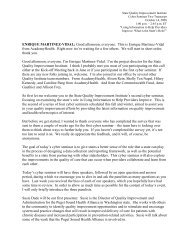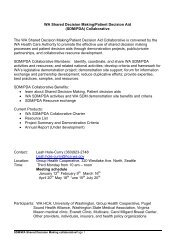Ohio Health Quality Improvement Plan
Ohio Health Quality Improvement Plan
Ohio Health Quality Improvement Plan
You also want an ePaper? Increase the reach of your titles
YUMPU automatically turns print PDFs into web optimized ePapers that Google loves.
Appendix IV — Co m m e n t s f r o mStatewide Or g a n iz a t io n s5.6.Payment policies should foster ways to reduceexpenditures on administrative processes (e.g.,claims payment and adjudication).Reforms to payment should balance the need forurgency against the need to have realistic goalsand timelines that take into account the need tochange complex systems and geographic and othervariations.Academy of Medicine of Cleveland &Northern <strong>Ohio</strong>The Academy of Medicine of Cleveland & Northern<strong>Ohio</strong> (AMCNO) the premier regional medical associationin Northern <strong>Ohio</strong> representing over 5,000 physicians ispleased to be involved in the development of the <strong>Ohio</strong><strong>Health</strong> <strong>Quality</strong> <strong>Improvement</strong> <strong>Plan</strong>. We believe that ourorganization could help implement any number of thestrategies and tactics, however, if we were to pick onethat is a priority for our organization it would be theimplementation of an appropriate health informationtechnology (HIT) infrastructure which is of utmostimportance to both physicians and our patients in the future.In order to achieve the HIT goal interoperability issues andcost factors for physicians must first be addressed.With regard to the strategies and tactics outlined in theplan, clearly an HIT infrastructure will be necessary inorder to track patients and their records through a patientcentered medical home model, as well as to evaluatechronic diseases, patient compliance issues and follow-upcare.Physicians are faced with inefficient health systemspending that does not add any value to patient care, suchas excessive costs associated with dealing with the myriadof insurance companies. Real payment reform cannotbe achieved without the use of HIT to provide for theelectronic transfer of information between physicians andpayors on a real time basis. However, this will requirechanges not only on the part of physicians but uniformchanges by the insurance industry as well.The AMCNO is involved in many projects in our regiondealing with health information technology, developing apatient centered medical home model, and working withphysicians and our patients on chronic disease issues. Inaddition, payment reform and changes in the insuranceindustry have always been top of the mind for physiciansand their practice and we believe that there are changesthat could be made within the insurance industry that couldstreamline how physicians practice and save money in thelong run.Patients must be an integral part of the discussion as wellsince declining health status also contributes to medicalcosts. In addition to focusing on the HIT issue the councilshould strive to engage the consumers of health care in thisdebate to assure that there is a cultural transformation andpatients begin to take a proactive role in improving theirhealth status.The physician leadership of the AMCNO would be pleasedto participate in discussions on any of the strategies andtactics as this discussion continues in the future.American Heart AssociationOn behalf of the American Heart Association, I ampleased to offer comments on the <strong>Ohio</strong> <strong>Health</strong> <strong>Quality</strong><strong>Improvement</strong> <strong>Plan</strong>. Access to quality health care is anintegral component of our goal to reduce death, disabilityand risk from cardiovascular disease and stroke by 25% by2010. As we begin to look beyond 2010, access and qualityto care will become an even greater focus.As a research driven organization, we are committed tonot only fund needed research projects, but also to thetranslation of research into practice. This is the only wayto impact health quality, cost and disease prevention. TheAmerican Heart Association/American Stroke Associationrecognizes many collaboration points in the plan and looksforward to partnering and furthering the collaboration wehave already begun with other organizations.Patient-Centered Medical HomesThe system of care and active patient involvement iscritical. We are developing resources and utilizing HITand payment reform to increase the collaboration betweencomponents of the system of care. Additional links areprovided.<strong>Health</strong> Information TechnologyThe American Heart Association jointly published a <strong>Health</strong>IT roadmap in 2006 for cardiovascular disease and stroke.Those efforts continue through our development of newproducts and through partnerships. (Links can be foundbelow.) The organization is able to bring this knowledgeand success from other states to impact efforts in this area.31










